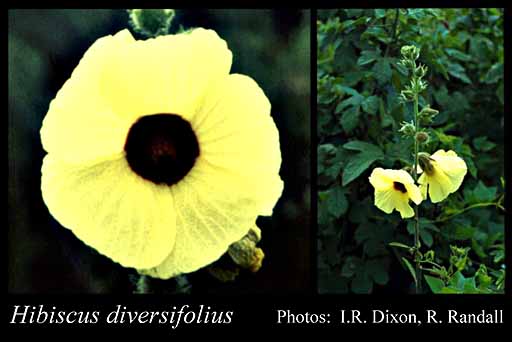This name is not current. Find out more information on related names.
- Reference
- Collect.Bot. 2:307-308 (1789)
- Conservation Code
- Not threatened
- Naturalised Status
- Native to Western Australia
- Name Status
- Not Current
Erect, spiny shrub, to 2 m high. Fl. yellow, Jan to Dec. Alluvium. River banks.

Management Notes (for the Swan NRM Region)
General Biology. Growth form. Shrub. Reproduction. Seed. Dispersal. Water. Time to first flowering. 1 year. Vegetative regeneration strategy. Resprouts and produces root suckers. Seedbank persistence. Medium, evidence of persistent soil seed bank. Fire response. Mature plants killed by hot fire. Can resprout after cool burn. Prolific germination of soil stored seed can follow fire.
Additional information. Origin. Tropical Africa, eastern Australia, New Guinea, the Philippines, many Pacific Islands, Central and South America and new Zealand. History of use/introduction. Garden escape.
Suggested method of management and control. Hand pull small plants ensuring removal of as much root material as possible. Foliar spray with 1.5% glyphosate or try cut and paint using 50% glyphosate. Read the manufacturers' labels and material safety data sheets before using herbicides. For further information consult the Australian Pesticides and Veterinary Medicines Authority to determine the status of permits for your situation or state.
Management Calendar
| Calendar Type | Jan | Feb | Mar | Apr | May | Jun | Jul | Aug | Sep | Oct | Nov | Dec | Comments |
|---|---|---|---|---|---|---|---|---|---|---|---|---|---|
| Flowering | Y | Y | O | O | Y | ||||||||
| Fruiting | Y | Y | Y | ||||||||||
| Optimum Treatment | O | O | O | O | O | O | O | O | O | O | O | O |
Legend: Y = Yes, regularly, O = Occasionally, U = Uncertain, referred by others but not confirmed.
References
- Benson, D. & McDougall, L. (1997) Ecology of Sydney plant species part 5: Dicotyledon families Flacourtiaceae to Myrsinaceae. Cunninghamia, 5 (2): 330-544.
- Brown, K. & Brooks, K. (2002) Bushland Weeds: A Practical Guide to their Management. Environmental Weeds Action Network, Greenwood.
- Hussey, B.M.J., Keighery, G.J., Dodd, J., Lloyd, S.G. & Cousens, R.D. (2007) Western Weeds. A guide to the weeds of Western Australia. 2nd Edition. The Plant Protection Society of Western Australia, Victoria Park.